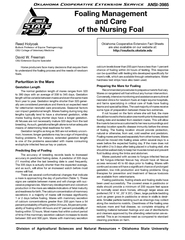/


Reed Holyoak Bullock Professor of Equine Theriogenology OSU College of Veterinary Medicine David W Freeman OSU Extension Equine Specialist Horse producers face many decisions that require them to un ID: 90481
Download Pdf The PPT/PDF document "Division of Agricultural Sciences and Na..." is the property of its rightful owner. Permission is granted to download and print the materials on this web site for personal, non-commercial use only, and to display it on your personal computer provided you do not modify the materials and that you retain all copyright notices contained in the materials. By downloading content from our website, you accept the terms of this agreement.
Division of Agricultural Sciences and Natural Resources • Oklahoma State University Reed Holyoak Bullock Professor of Equine Theriogenology OSU College of Veterinary Medicine David W. Freeman OSU Extension Equine Specialist Horse producers face many decisions that require them to understand the foaling process and the needs of newborn foals. Parturition in the Mare Gestation Length The normal gestation length of mares ranges from 320 to 380 days with an average of 338 to 345 days. Gestation length will be variable between mares and even the same mare from year to year. Gestation lengths shorter than 320 gener percent probability of foaling within 24 hours, 84 percent prob - ability of foaling within 48 hours and 97 percent probability of foaling within 72 hours. Most mares foal within a short period of time if the mammary secretion calcium increases to levels between 300 and 500 ppm. Mares with mammary secretion calcium levels lower than 200 ppm have a less than 1 percent chance of foaling within 24 hours of testing. This response can be quanti�ed with testing kits developed speci�cally for mare’s milk, which are available through veterinarians. Water hardness test strips have also been used. Preparing the Mare for Foaling Recommended procedures to prepare a mare to foal vary. Mares on rangeland will foal without any human intervention. of foaling. The foaling location should provide protection, natural or otherwise, from wet, cold weather and predators. Foaling mares are housed separately from other horses. Mares should be moved into foaling areas within several days to a week before the expected foaling day. If the mare does not foal within 2 to 3 days after being placed in a foaling stall, she should be walked daily to keep her muscles toned and prevent Mares pastured with access to fungus-infected fescue or fed fungus-infected fescue hay should have all fescue access removed 45 to 60 days prior to foaling. Mares with continued access will have a signi�cant chance of prolonged gestation, low milk production and foaling problems. Drug therapies for prevention and treatment of fescue toxicosis are available from veterinarians. Foaling paddocks, foaling sheds and foaling stalls have been used successfully. The covered areas in paddocks or stalls should provide a minimum of 200 square feet space for normally sized stock horses, although larger areas are preferred (16’ X 16’, 20’ X 20’). Clean, large particle bedding such as green grass in paddocks or straw in stalls is desir - able. Smaller particle bedding such as shavings may collect